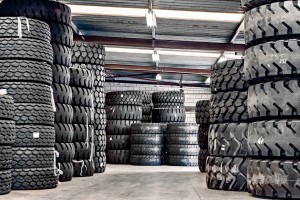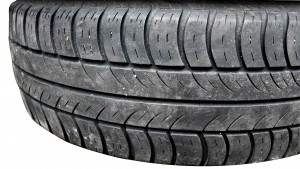The onslaught of Chinese CV tyres is hurting the domestic tyre industry.
Story by: Anirudh Raheja
Inderjeet Singh Bawa from Ludhiana is contemplating replacing the worn out tyres of his 4×2 Ashok Leyland Comet Gold 1613 truck. The existing set of tyres has clocked almost 70,000kms (69,974kms to be precise). Bawa is scouting various options; he is worried about the expenses involved in the purchase of a new set of tyres, what with one tyre costing between Rs.18000 and Rs.20000. TCO is dear to Bawa like the numerous other truck operators, big and small. More so in an environment where freight rates are not showing signs of a good climb, and business is not particularly looking very promising. Compelled to keep the costs down, Bawa learns of Chinese tyres on offer from one of the many people in his field that he often talks to. Bawa is lured to check out these tyres because of the considerable price advantage they may offer over Indian-made tyres. It is cost that is the prime criteria that is providing Chinese tyres a foothold in the one-million Indian tyre market.
Challenges
Until almost half a decade ago, the demand and supply for natural rubber was on par. India was perhaps the only market in the world where the production of natural rubber, and production and consumption of tyres was balanced. The dependence on imports was negligible. However, Chinese tyres, over the past few years have altered the situation. Expresses Rajiv Budhraja, Director General, Automotive Tyres Manufacturers Association, “Only 40,000 tyres were imported every month until a few years ago. The monthly Chinese truck and bus tyre import figures have touched one and a half lakh units.” The import of one and a half lakh truck and bus tyres was clocked in June 2016, and is said to be growing at a brisk pace. For a price sensitive buyer like Bawa, Chinese tyres make an attractive option.
Known as the manufacturing hub of the world, China builds almost everything. It is also known to offer the best quality and the worst quality products.Says Budhraja, “Tier-one and tier-two tyre manufacturers are supplying high-end products (from China). Of much concern are the tier-three tyre suppliers that emerge like wild mushrooms. They may have reduced in numbers, down to 250 from 1000, they are however continuing to damage the Indian tyre industry. They are finding a way into the market with the help of small-time importers and exporters.” He adds,”What is worrying is that these are unknown brands; they are not competitively priced, nor do they have selling strategies on par with market standards. They evade taxes and duties, and cause a snowball effect on the domestic industry. The manufacturers are largely driven by the prospect of exports, and can make tyres of a particular brand name. This causes the volumes to spike up or fall in a short duration of time.”
Falling natural rubber production a concern
It is no secret that the tyre industry is raw material intensive. Close to 70 per cent of the raw material input costs in a tyre are that of rubber. Of this, close to 45 per cent is contributed by natural rubber. With the content of natural rubber high in CV tyres by up to 90 per cent when compared to passenger car tyres, the falling production of natural rubber is a matter of concern. In contrast, vehicle production in India has soared. It clocked 20 million units in 2015. With the procurement of natural rubber an area of concern, industry experts claim that it is necessary to take drastic steps so that rubber production goes hand-in-hand with the consumption requirement of the tyre industry. They draw attention to the time when rubber production was 1800 kg per hectare. In 2015, natural rubber production hovered around 5.6 lakh MT, down from 8.2 lakh MT in 2009. Natural rubber production declined by over 60 per cent within a span of three years post 2009. States Budhraja, that almost 90 per cent of the rubber produced in India is in Kerala. As pressure on land increased, land used to produce rubber was converted to purposes like tourism, which would ensure a higher yield. Adds Budhraja, that wages in Kerala are high and rubber, a long gestation period crop, in the face of other resources like rentals and gulf remittances, is facing the brunt. The gap between domestic production and consumption of rubber is widening.
Unable to address demand
In 2011-12, the tyre industry posted a growth of eight per cent. It was expected of the tyre industry to keep growing; to perform well. In anticipation of this, investments of up to Rs.40,000 crores have been made till date, focussing largely on truck and bus radial segment. CV sales have unfortunately tapered. This has led to the building up of surplus capacity. While the tyre industry in India invested in capacity, a similar exercise in China was also carried out. China currently has a capacity, which is almost two and a half times more than what it needs. Facing anti-dumping duties in markets like US, Chinese tyre manufacturers started dumping tyres in India, and at a cost that does not even cover the raw material costs in India. “You can assess whether a tyre is coming at a fair price or not by ascertaining it on cost and construction based on the international cost of raw material,” says Budhraja.
System complexities
A statement issued by Automotive Tyre Manufacturers’ Association (ATMA) mentions that the dumping of Chinese tyres in India is fuelled by high rubber prices in India. Rubber prices are claimed to be 20 per cent more than that in the international markets. An inverted duty structure in the rubber industry adds to the challenge, dampening industry growth prospects. Claims an industry source, that the custom duty on rubber is 25 per cent or Rs.30 per kg, whichever is lower. The basic duty on tyres, he adds, is however 10 per cent, which is even lower under various trade agreements. “You can import tyres from the ASEAN region, South Africa, South Korea, and even China at a rate that is lower than the basic rate of 10 per cent. This can further hover between zero and five per cent up to 8.6 per cent depending upon the trade agreement,” opines Budhraja. Thus a peculiar situation arises where the principal raw material, largely dependent on imports, is had at 25 per cent. Finished product can be imported into the country at a very low rate of duty. Adds Budhraja, “There are many uncertainties when it comes to import and export policies, which are subject to change at a short notice. The commitment for both, the export of finished products and import of raw material, are developed over a long-term. Restriction on import of rubber against advanced licence for a few months until March 31, 2016, play an important role in determining industry growth. Also, does the pre-import condition where the rubber has to be imported ahead of exports to qualify for the advance licence.”
Rising radialisation
Demand for radial tyres in CVs is on the rise. With radialisation level of 40 per cent, there is good potential for the CV radial tyre market to grow. Estimated to be growing at four to five per cent, the trend, says Budhraja, is expected to continue until 70 per cent radialisation is achieved. This, he adds, is expected to take place in the next three to four years. Barring some specific applications in mining and farm equipment, Budhraja is of the opinion that the shift to radials must happen. OEMs, he avers, are already playing an important role with the radialisation at 70 per cent levels currently. The need, emphasises Budhraja, is to reach 90 to 95 per cent at the OE end over the next three to four years. Bias tyres, he is certain, will not see the end of the road soon. Their sale may decline, and they may continue to face negative growth, their application in specific areas will continue. Points out Budhraja, that radial tyres are being pushed by OEMs on high-end models, which also make high growth segments. The need is to widen the scope of radial tyres to basic models, and to improve market penetration of radial tyres.
Market dilemma
The typical OE aftermarket ratio as far as CV tyres are concerned is 35:65. Despite the OE market being considerably smaller than the replacement market, tyre manufacturers seem to be keen to carve out a larger pie of that market. This is despite the fact, that returns are not as per the expectations. This however is not the reason why Chinese tyres are finding easier access to the Indian aftermarket, claims an industry source. They find takers, he adds, because of the cost at which they are offered. Says Budhraja, “Aftermarket potential is huge, however OE market makes big sense for tyre manufacturers. Even if 50 per cent of the OE fitment brings in replacement market demand, there is a lot for a tyre manufacturer to gain.” Hoping for emergence of strong demand from the rural sector, Budhraja avers, “We also have a lot of cross-state movement of food grains, which means great demand for CV segment. With an improvement in infrastructure, disposable income, and mobility, the tyre industry can look at good growth.”
Beyond carving out a place in the aftermarket, Chinese CV tyres are starting to affect the retreading business. A buyer can avail of a new tyre at a cost that is not significantly high, claims an industry source. He adds, with the current economy levels, it is quite likely that a CV tyre buyer will look for cost over many other parameters since for him a tyre is a tyre. Mentions Budhraja, “If the economy gains traction, we could see mid-single digit growth in the CV segment. India is a strong economy, and companies would not set up shop on the basis of exports alone. Even if exports amount to 20 per cent, a company would chalk out its plans according to the domestic market prospects.”
Government role
The Goods and Services Tax (GST) Bill has been passed, and is expected to play a vital role in reducing the check posts and barriers. Local taxes are expected to go away, and with it, unwanted activities like baseless checks and harassment of CV drivers. The tyre industry, says Budhraja, is seeking correction in the inverted duty structure. “It is long overdue, and can be done in two ways. Either by reducing the duty on rubber to five to seven per cent, or by increasing the duty on a tyre to a rate closer than that of the rubber,” he adds. Tyre manufacturers have set up capacities at a certain cost. They are aware of the widening gap between rubber production and consumption. There is a growing demand from the industry for allowing the import gap on a Tariff Rate Quota (TRQ) where a fixed quantity of import can be allowed on a differential tariff similar to other commodities like palm oil and corn. “As the gap assessment is done by the government and not the industry, the assessment can be made by the rubber board (a commerce ministry arm) to ascertain the gap and allow differential rate to control costs,” says Budhraja. Government restrictions mean rubber can be imported only through the ports of Chennai and Nhava Sheva in Navi Mumbai. Tyre industry sources claim that tyre companies that have infrastructure away from these ports have to incur extra costs. It was easier earlier when they could get the rubber cleared from Inland container ports. It is expected of the government, concludes Budhraja, to speedily address the issues that are eroding the competitiveness of the tyre industry.





























